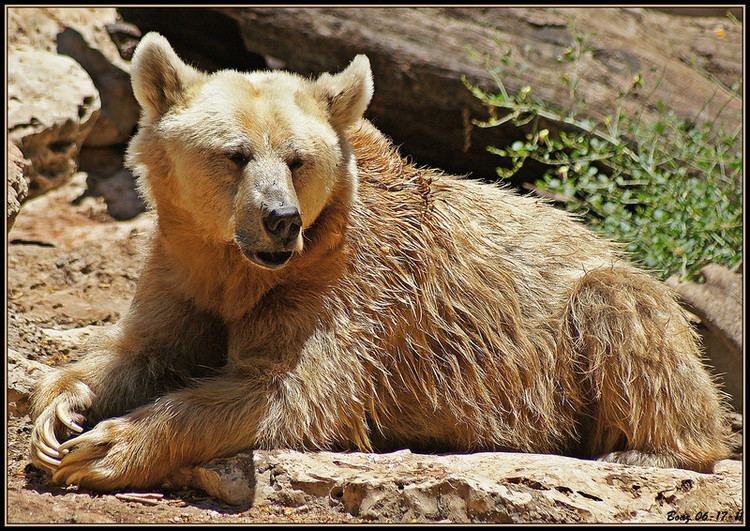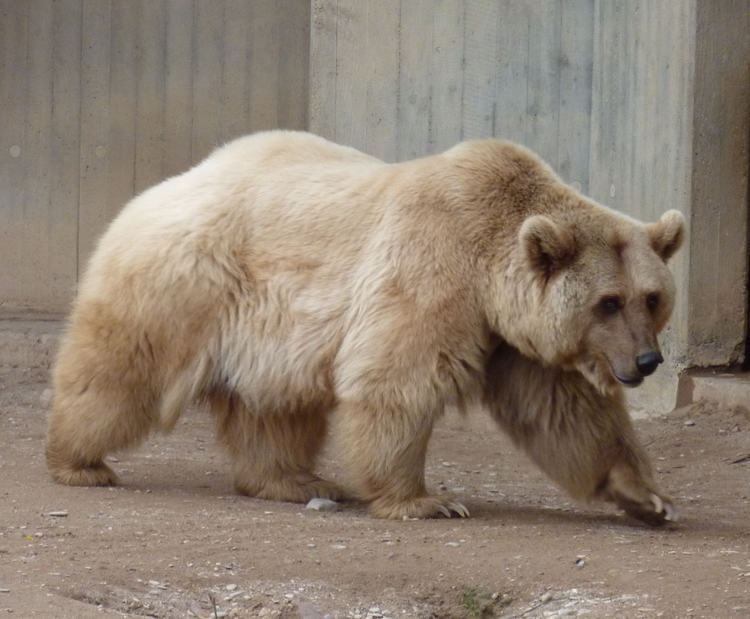Genus Ursus Higher classification Brown bear | Phylum Chordata Family Ursidae Scientific name Ursus arctos syriacus Rank Subspecies | |
 | ||
Similar Bear, Brown bear, Bears, Eurasian brown bear, Himalayan brown bear | ||
Syrian brown bear
The Syrian brown bear (Ursus arctos syriacus) is a relatively small subspecies of brown bear native to the Middle East.
Contents
- Syrian brown bear
- Millie our syrian brown bear at 9 months old
- Evolutionary history
- Description
- Habitat and distribution
- Threats
- Wojtek
- References

Millie our syrian brown bear at 9 months old
Evolutionary history

A genetic study shows that all brown bears occurring in the Caucasus at least matrilineally are monophyletic and belong to Eurasian brown bear (Ursus arctos arctos).
Description

The Syrian brown bear is one of the smaller subspecies of brown bears, although brown bears as a group are among the largest type of bears, only second to polar bears. Adult males have skulls measuring approximately 30 – 40 cm. The Syrian brown bear weighs up to 550 pounds (250 kg) and measures from 101 – 140 cm from nose to tail. It is overall the smallest bear of the Ursus arctos species.

Fur color is usually very light brown and straw coloured. The hair on the withers is longer with a grey-brown base and is often a different shade than the rest of the body, seen in some individuals as a dark stripe running across the back. The lighter colors usually appear at higher altitudes. Their legs are commonly darker than the rest of their body. It is the only known bear in the world to have white claws.

Populations from Caucasus, whose ranges was thought to belong to Ursus arctus syriacus and to overlap those of Eurasian brown bears, belong in deed to this nominal subespecies, so are larger in size and darker. In the past some naturalists proposed that Casucasian bears belonged to hybrid populations between Eurasian and Syrian brown bears, but the genetic studies show that all populations in Caucasus are pure Eurasian brown bears. It was thought that these mixed bears originated during the Holocene when Syrian bears supossedly migrated Northward and interbred with the larger Northern bears. Today that hypothesis is considered by experts as wrong.
Habitat and distribution

Generally found in the mountainous areas throughout its home range, the Syrian brown bears seem to den and hibernate in caves and tree hollows of the birch forests, which are found at higher elevations than pine and other trees. Outside of hibernation these bears tend to forage for food in grasslands, meadows, forests and have been known to enter mountain villages to feed on grains and nuts.
Within the former Soviet Union, it occurs in Turkmenistan. Outside the ex-USSR,It occurs in Iran, Iraq and Turkey. It is extinct in Israel, and, more recently, in Syria. The Syrian brown bear may still exist in Lebanon.
Threats
Like many large mammals, the Syrian brown bear population is declining due to habitat loss, and poaching. They are a popular target for big game hunters in the Middle East and in Asia. In addition, bear bile (ursodeoxycholic acid) is a valuable commodity because of its use in traditional Chinese medicine as an assumed cure for rheumatism, poor eyesight and gall stones.
Wojtek
Among the huge variety of troops serving at Monte Cassino, probably the strangest was a bear from Iran, called Wojtek. Raised by and enlisted into the 22nd Artillery Supply Company of the Polish II Corps, he carried artillery shells during battle.
